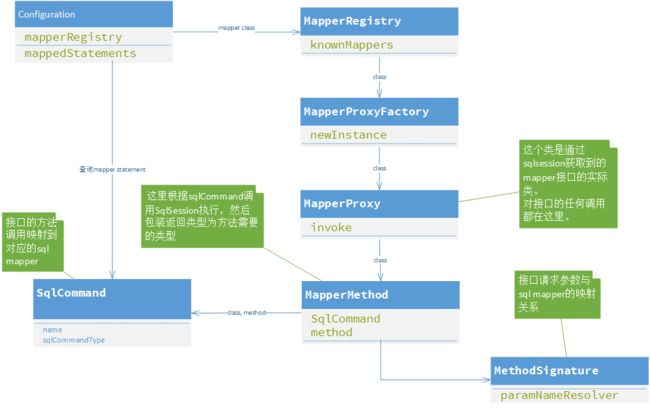通过mapper interface使用Mybatis应该是最为通用的一种使用方式,通过这种方式阅读起来清晰明了,同时又合适的屏蔽了细节。 但是,Mybatis是如何让自定义接口可以实现种种数据库操作的功能,是一个非常有趣的问题。
1. 开始
但是这节我们不直接从接口开始,先从架构图中最“大”的一部分-配置 开始说起。
作为Mybatis中牵连最广的一个类,Configuration类承担起了如下3个任务:
- 为所有类提供可自定义的配置的读取的功能
- 读取相关配置文件:
- mybatis配置文件,比如mapper文件位置,插件等等
- mapper xml文件的读取
- mapper interface与xml的映射
之所以把配置这个类放在最前面而不是SqlSessionFactory,是因为这个这个工厂类的建立者SqlSessionFactoryBuilder事实上就是调用 XMLConfigBuilder类构建了一个Configuration。
而Mybatis使用mapper interface的方式很简单
SqlSession session = sqlSessionFactory.openSession();
try {
BlogMapper mapper = session.getMapper(BlogMapper.class);
Blog blog = mapper.selectBlog(101);
} finally {
session.close();
}
所以我们这里关注mybatis为何能获取到这个接口的实例,获取到的实例到底是什么类型以及是如何影响到数据库的。
2. 整体结构
前面说过, Configuration类维护了mapper xml与mapper接口的映射关系, 但是事实上 Configuration类的成员变量显示并没有类似Map的成员,那么他们是怎么关联起来的呢?
同时,当我们通过SqlSession获取到一个mapper的接口实例时, 对这个接口的方法调用是如何映射到对应的mapper文件中的xml声明呢?
这里我们先跳过上面所列出的配置文件与mapper xml文件读取, 先看下对一个接口中某个方法调用一系列的流程:
3. 主要流程:
1.Configuration类持有了一个包含所有mapper xml的映射结果集, 一个MapperRegistry实例。
2.MapperRegistry实例持有所有的mapper接口的Class与MapperProxyFactory映射结果集
这里之所以是一个工厂而不是直接生成一个代理类,是因为每个代理类都需要与SqlSession关联,每次调用都不同,所以需要动态生成
public T newInstance(SqlSession sqlSession) {
final MapperProxy mapperProxy = new MapperProxy(sqlSession, mapperInterface, methodCache);
return newInstance(mapperProxy);
}
3.MapperProxy会对方法调用做些判断,但是最终调用的是MapperMethod的方法
public Object invoke(Object proxy, Method method, Object[] args) throws Throwable {
try {
if (Object.class.equals(method.getDeclaringClass())) {
return method.invoke(this, args);
} else if (isDefaultMethod(method)) {
return invokeDefaultMethod(proxy, method, args);
}
} catch (Throwable t) {
throw ExceptionUtil.unwrapThrowable(t);
}
final MapperMethod mapperMethod = cachedMapperMethod(method);
return mapperMethod.execute(sqlSession, args);
}
4.MapperMethod中有2个成员变量
-
SqlCommand类型的command成员
该变量在构造的时候会通过当前接口调用的class名称和method名称在Configuration类中寻找对应的缓存。//这里是绑定xml声明与与方法的关键部分 public SqlCommand(Configuration configuration, Class mapperInterface, Method method) { final String methodName = method.getName(); final Class declaringClass = method.getDeclaringClass(); MappedStatement ms = resolveMappedStatement(mapperInterface, methodName, declaringClass, configuration); if (ms == null) { if (method.getAnnotation(Flush.class) != null) { name = null; type = SqlCommandType.FLUSH; } else { throw new BindingException("Invalid bound statement (not found): " + mapperInterface.getName() + "." + methodName); } } else { name = ms.getId(); type = ms.getSqlCommandType(); if (type == SqlCommandType.UNKNOWN) { throw new BindingException("Unknown execution method for: " + name); } } } //根据class.method寻找 private MappedStatement resolveMappedStatement(Class mapperInterface, String methodName, Class declaringClass, Configuration configuration) { String statementId = mapperInterface.getName() + "." + methodName; if (configuration.hasStatement(statementId)) { return configuration.getMappedStatement(statementId); } else if (mapperInterface.equals(declaringClass)) { return null; } for (Class superInterface : mapperInterface.getInterfaces()) { if (declaringClass.isAssignableFrom(superInterface)) { MappedStatement ms = resolveMappedStatement(superInterface, methodName, declaringClass, configuration); if (ms != null) { return ms; } } } return null; } -
MethodSignature类型的method成员则负责把接口的参数与mapper xml的参数对应起来。
在上面2个成员变量的初始化都完成过后, 对方法的调用就很简单了://节选 public Object execute(SqlSession sqlSession, Object[] args) { Object result; switch (command.getType()) { case INSERT: { Object param = method.convertArgsToSqlCommandParam(args); result = rowCountResult(sqlSession.insert(command.getName(), param)); break; } case UPDATE: { Object param = method.convertArgsToSqlCommandParam(args); result = rowCountResult(sqlSession.update(command.getName(), param)); break; }
特别注意sqlSession.insert(command.getName(), param)这段代码。它意味着 ,对接口的方法的调用最终还是回归到了mapper xml的调用。 这里根据解析出来的不同的命令类型分别调用SqlSession提供的不同的增删改查接口,然后包装下返回结果就完成了。
所以说SqlSession的insert,update,delete接口又是如何实现的呢? 配置文件解析又是怎么做的? 下篇再分析。
